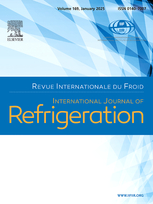
IIR document
Vortex tube shape optimization for hot control valves through computational fluid dynamics.
Author(s) : QYYUM M. A., NOON A. A., WEI F., et al.
Type of article: Article, IJR article
Summary
A vortex tube (VT) is a thermofluidic device that generates cold and hot streams from a single injection of compressed gas. This interesting phenomenon of energy separation is due to fluid dynamic effects. In this study, the optimization of the VT geometry was performed to investigate the potential applications of the VT as an expansion device in natural gas processing and air separation industries. A steady-state computational fluid dynamics (CFD) model with the standard k–? turbulence was used to solve the hydrodynamics of the highly compressible, turbulent, and swirling flow within the VT. Velocity streamlines and temperature distributions of the separated air stream were obtained for different control valve shapes located at a hot end. The CFD results showed the effects of the control valve shape, cone valve geometry, and nozzle inlet pressures on the VT performance. A truncated cone control valve with an optimized geometry was found to be the best choice for thermal performance enhancement of the VT. The CFD results were validated with experimental data, and the difference in the cold temperatures between the numerical and experimental values were less than 4.12% for the 2D and 2.3% for the 3D vortex tube models.
Available documents
Format PDF
Pages: 151-158
Available
Public price
20 €
Member price*
Free
* Best rate depending on membership category (see the detailed benefits of individual and corporate memberships).
Details
- Original title: Vortex tube shape optimization for hot control valves through computational fluid dynamics.
- Record ID : 30025869
- Languages: English
- Source: International Journal of Refrigeration - Revue Internationale du Froid - vol. 102
- Publication date: 2019/06
- DOI: http://dx.doi.org/10.1016/j.ijrefrig.2019.02.014
Links
See other articles in this issue (15)
See the source
Indexing
-
Experimental investigation and industrial appli...
- Author(s) : GUTAK A. D.
- Date : 2015/01
- Languages : English
- Source: International Journal of Refrigeration - Revue Internationale du Froid - vol. 49
- Formats : PDF
View record
-
Numerical investigation of gas species and ener...
- Author(s) : DUTTA T., SINHAMAHAPATRA K. P., BANDYOPADHYAY S. S.
- Date : 2011/12
- Languages : English
- Source: International Journal of Refrigeration - Revue Internationale du Froid - vol. 34 - n. 8
- Formats : PDF
View record
-
Limiting values of thermodynamic characteristic...
- Author(s) : LAVRENCHENKO G. K.
- Date : 1993/11
- Languages : English
- Source: Cryogenics - vol. 33 - n. 11
View record
-
PIV measurements of velocity of water in the pr...
- Author(s) : SEYBERT C. D., EVANS J. W.
- Date : 2005/01
- Languages : English
- Source: International Journal of Heat and Mass Transfer - vol. 48 - n. 1
View record
-
Semi-empirical turbulence model for numerical s...
- Author(s) : KHAIT A. V, NOSKOV A. S., LOVTSOV A. V., et al.
- Date : 2014/12
- Languages : English
- Source: International Journal of Refrigeration - Revue Internationale du Froid - vol. 48
- Formats : PDF
View record
